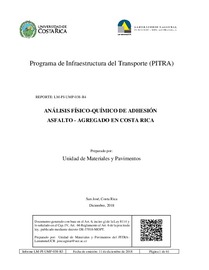| dc.contributor.author | Baldi Sevilla, Alejandra | |
| dc.contributor.author | Salazar Delgado, Jorge | |
| dc.contributor.author | Rodríguez Castro, Ellen | |
| dc.date.accessioned | 2019-05-31T17:43:19Z | |
| dc.date.available | 2019-05-31T17:43:19Z | |
| dc.date.issued | 2018 | |
| dc.identifier.uri | https://www.lanamme.ucr.ac.cr/repositorio/handle/50625112500/1711 | |
| dc.description.abstract | El daño por humedad es una de las fallas más importantes que deterioran el pavimento. Se ha reconocido que este tipo de daño responde al debilitamiento de la interacción entre el asfalto y el agregado (reducción de adhesión) y el debilitamiento de las interacciones cohesivas en el asfalto, ambos por efecto del agua. Producto de ello, ocurre el desprendimiento del asfalto de la superficie del agregado (desnudamiento) y el desprendimiento de agregados de la superficie del pavimento (desmoronamiento). Desde esta perspectiva, el daño por humedad es el detonante de otros mecanismos de falla y podría resultar tan severo que provoque la pérdida total de la mezcla asfáltica. Sin embargo, existen otros factores que contribuyen al daño por humedad, tales como el diseño de mezcla (materiales seleccionados, contenido de vacíos y de asfalto), la producción y construcción del pavimento, factores ambientales, entre otros. Por lo tanto, no es posible definir completamente el daño por humedad con base en mecanismos individuales tales como desnudamiento o desmoronamiento, es necesario desarrollar una visión integral del fenómeno. Por esta razón, la presente investigación busca abordar el proceso de daño por humedad desde la perspectiva fundamental (dada por fisicoquímica de las superficies) hasta sus repercusiones a nivel mecánico. Con tal de alcanzar este objetivo, se contó con varias fuentes tanto de agregado como de asfalto, las cuales fueron características en términos de energía superficial. Adicionalmente, con estos materiales se produjo mezcla asfáltica, cuyo desempeño mecánico fue evaluado en condiciones húmedas. Los resultados obtenidos permiten enlazar las propiedades de superficie de los materiales con su comportamiento real en presencia de agua, utilizando ciertos parámetros fisicoquímicos relacionados con la compatibilidad del asfalto y el agregado con el agua. De manera adicional, se logró establecer una relación entre el proceso de adhesión (y de desplazamiento en presencia de agua) y la polaridad tanto del asfalto como del agregado. | |
| dc.description.abstract | Moisture damage is one of the most important faults that deteriorate the pavement. It has been recognized that this type of damage responds to the weakening of the interaction between the asphalt and the aggregate (reduction of adhesion) and the weakening of the cohesive interactions in the asphalt, both due to the effect of water. As a result of this, the asphalt detachment from the surface of the aggregate (stripping) and the detachment of aggregates from the surface of the pavement occur. From this perspective, moisture damage is the trigger for other failure mechanisms and could be so severe that it causes the total loss of the asphalt mixture. However, there are other factors that contribute to moisture damage, such as the mix design (selected materials, voids and asphalt content), pavement production and construction, environmental factors, among others. Therefore, it is not possible to completely define the moisture damage based on individual mechanisms such as stripping or crumbling, it is necessary to develop a comprehensive vision of the phenomenon. For this reason, the present research seeks to approach the process of moisture damage from the fundamental perspective (given by physical chemistry of the surfaces) to its repercussions at the mechanical level. In order to achieve this goal, there were several sources of both aggregate and asphalt, which were characteristic in terms of surface energy. Additionally, asphalt mixture was produced with these materials, whose mechanical performance was evaluated in humid conditions. The results obtained allow linking the surface properties of the materials with their actual behavior in the presence of water, using certain physicochemical parameters related to the compatibility of the asphalt and the aggregate with the water. Additionally, a relationship was established between the adhesion process (and displacement in the presence of water) and the polarity of both the asphalt and the aggregate. | |
| dc.language.iso | es | es |
| dc.publisher | Laboratorio Nacional de Materiales y Modelos Estructurales (LanammeUCR) | es |
| dc.subject | Adhesión | es |
| dc.subject | Cohesión | es |
| dc.subject | Energía superficial | es |
| dc.subject | Desempeño | es |
| dc.subject | Adhesion | es |
| dc.subject | Cohesion | es |
| dc.subject | Surface energy | es |
| dc.subject | Performance | es |
| dc.title | Análisis físico-químico de adhesión asfalto-agregado en Costa Rica | es |
| dc.title.alternative | LM-PI-UMP-038-R4 | es |
| dc.type | informe técnico | es |
| dc.description.procedence | UCR::Vicerrectoría de Investigación::Unidades de Investigación::Ingeniería::LanammeUCR | es |

